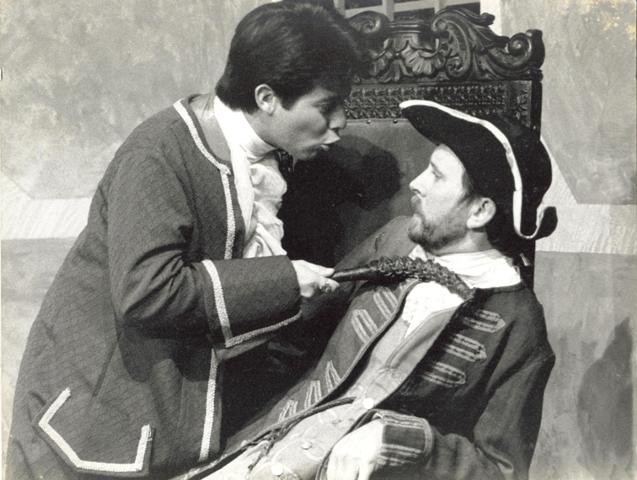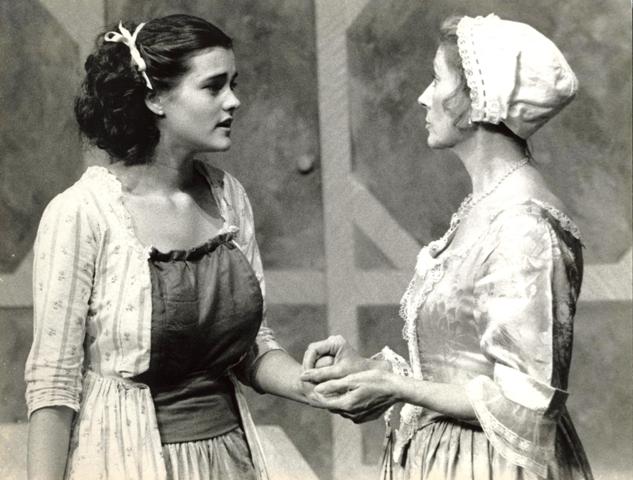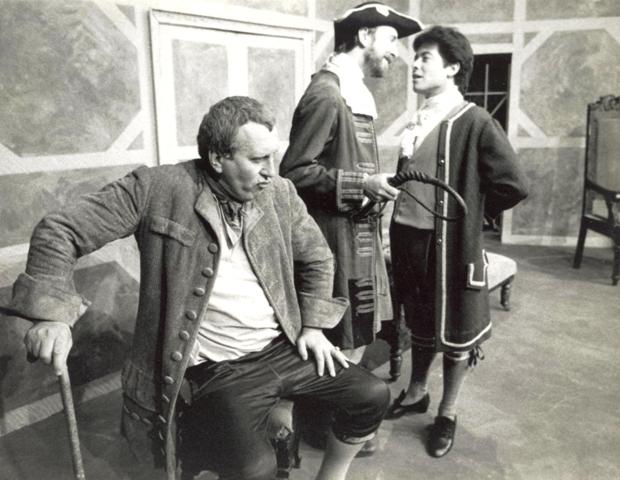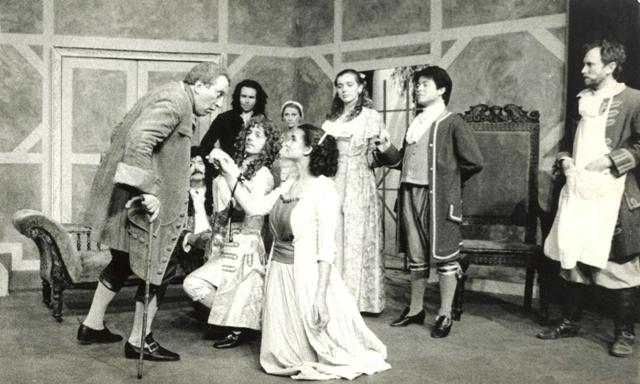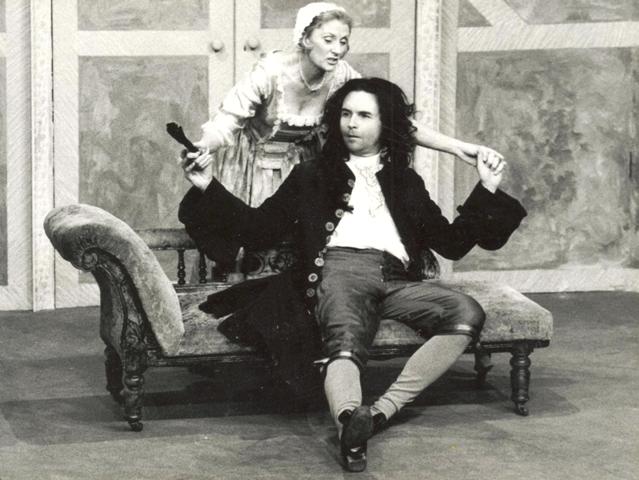The Miser
Written by Molière
Thurs 30th November - Sat 2nd December & Tues 5th - Sat 9th December 1989
Directed by Vincent Adams
The Miser and his son wish to marry the same girl. His daughter wishes to marry the butler. Add to this the 10,000 crowns hidden in the garden and Molière's classic farce brings to life the conflict between young lovers and an avaricious old fool.
previous
production
next
production
Jean-Baptiste Poquelin (1622 - 1673)
Born Jean-Baptiste Poquelin, the actor and author (who later changed his name to Molière) was born in to a prosperous family in Paris. Initially educated at the College de Clermont in Paris, at the age of twenty-one, Jean-Baptiste founded a dramatic troupe called The Illustrious Theatre and it was about this time that he changed his name to Molière. Initially untrained and unsuccessful in Paris, the company went on a tour of the provinces for twelve years. It was during this period that Molière began to write plays for the company and his first significant work was 'L'Etourdi' (The Blunderer). Shortly after its production the company returned to Paris and in 1658 they performed one of Molière's plays, 'Le Docteur Amoureux' (The Doctor in Love) before the King. Its success enabled the company (known thereafter as the Troupe de Monsieur) to be granted use of the Hôtel du Petit Bourbon, one of the three most important theatres in Paris.
The first of Molière's plays to be presented at the Petit Bourbon was Les Précieuses Ridicules (The Pretentious Ladies) which satirized Madame de Rambouillet. While the play itself was successful, its subject matter angered the object of its satire. Madame de Rambouillet had performances of the play suspended for fourteen days and eventually arrange for the Petit Bourbon to be closed completely. The King however granted Molière use of the Théâtre du Palais Royal where he would direct his own plays and often played the leading role himself. Though he received the adulation of the court and Parisians, Molière's satires attracted criticisms from the Roman Catholic Church. 'Tartuffe ou L'Imposteur' (Tartuffe or the Hypocrite) and its attack on religious hypocrisy received condemnations from the Church, while 'Dom Juan' was banned from performance.
Suffering from pulmonary tuberculosis, Molière experienced a hemorrhage while playing the role of the hypochondriac Argan in 'The Imaginary Invalid'. He died later that night but, having been excommunicated by the church, local priests refused to take his confession and they would not permit him to be buried in holy ground. Four days later, the King interceded and Molière was finally buried in the Cemetery Saint Joseph. He left a body of work of over 35 plays including 'The School for Husbands', 'The School for Wives', 'The Misanthrope', 'Tartuffe' and 'The Miser' and is considered one of the greatest masters of comedy in Western literature.
top of page
'The Miser' (L'Avare) was written in 1668 and was first performed in that year at the Palais Royal. Little is known about the original performance, although it is said that Molière himself played Harpagon, utilising his chronic cough and gait to humorous effect.
The action of this comedy of manners takes place during one day in the house of Monsieur Harpagon, a rich money-lender, in Paris in the year 1668. It follows the story of Harpagon and his children who long to escape from his penny-pinching household and marry their respective lovers. It is less savage, however, and somewhat less realistic than Molière's earlier play, 'Tartuffe', which attracted a storm of criticism on its first performance. The play is also notable for the way in which it sends up certain theatrical conventions. Many comedies from the Elizabethan period and onwards contain asides which are delivered by characters to the audience and which the other actors ignore. In 'L'Avare', however, characters generally demand to know who exactly these asides are being delivered to. The play's ending is also self-consciously ridiculous, mocking the French idea of comedy to better the comical effect of the play and its parts, while still taking in hand the tragedy of Harpagon and his life.
top of page

This play was staged at Havant Arts Centre, East Street Havant - Bench Theatre's home since 1977.
| Valere (inlove with Elise) | Alan Jenkins |
| Elise (Harpagon's daughter) | Justine Spencer |
| Cleante (Harpagon's son) | Steven Foden |
| Harpagon (the Miser) | Peter Corrigan |
| La Fleche (Cleante's servant) | David Penrose |
| Master Simon (a moneylender) | Howard Cawte |
| Frosine (a scheming woman) | Ruth Prior |
| Jacques (cook and coachman) | Peter Holding |
| 1st Servant | Terry Cattermole |
| 2nd Servant | Peter Le Feuvre |
| Mariane (in love with Cleante) | Justine Spencer |
| Justice of the Peace | Terry Cattermole |
| Clerk to the Justice | Howard Cawte |
| Seigneur Anselm | Peter Le Feuvre |
Crew
| Director | Vincent Adams |
| Stage Manager | David Hemsley-Brown |
| Lighting Design | Jacquie Penrose |
| Lighting and Sound Operation | Rob Finn |
| Costume | Robbie Cattermole |
| Set Design | David Penrose |
| Set Construction | David Hemsley-Brown |
| Front of House | John Scadding |
Director's Notes
Molière drew mostly from the traditions of farce and the commedia dell'arte for his work. Using the earthy reality of the former and the imaginative caricature of the latter, he created a theatrical experience that used to the full the comic tradition. He did not seek to preach a message but used the physical to symbolize the moral. 'L'Avare' is full of potent illustrations of moral qualities; nothing is described, everything is shown in and by the physical act.
Molière derives much of his comedy from human behaviour under the pressure of emotion, conveying this through the concentration of dramatic energy, in character and situation. Excitability of any kind, whether mania, anger or simply fun, often leads to incoherence, and the language of Molière shows with some variety this clash of man and speech; Harpagon cannot find words to describe his feeling when he fears for the security of his beloved money. It has been suggested that such as avaricious obsession could only be the subject of tragedy and certainly there is much in Molière's comic vision that includes the tragic, the sinister and the bitter. However, this must not be taken as a morbid preoccupation , but as part of the author's intention to expose the immoral and inhuman qualities evident in society. There must have been a few incipient Harpagons in a contemporary Parisian audience and such themes are far from irrelevant in the current climate of our own social situation.
Vincent Adams
top of page
Production Photographs

